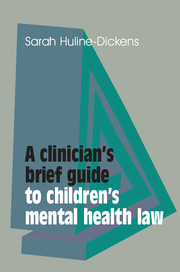Book contents
- Frontmatter
- Contents
- Foreword
- Acknowledgements
- List of cases
- Common abbreviations and terms
- 1 Introducing child mental health and the law
- 2 The rights of the child
- 3 The Children Act 1989 and the 2004 amendments
- 4 Consent to treatment
- 5 Confidentiality
- 6 The Mental Health Act
- 7 The Mental Capacity Act
- 8 Juvenile justice
- References
- Index
2 - The rights of the child
Published online by Cambridge University Press: 02 January 2018
- Frontmatter
- Contents
- Foreword
- Acknowledgements
- List of cases
- Common abbreviations and terms
- 1 Introducing child mental health and the law
- 2 The rights of the child
- 3 The Children Act 1989 and the 2004 amendments
- 4 Consent to treatment
- 5 Confidentiality
- 6 The Mental Health Act
- 7 The Mental Capacity Act
- 8 Juvenile justice
- References
- Index
Summary
The European Convention on Human Rights (ECHR) was drawn up in the wake of the Second World War and was signed by the UK government in 1950. However, the Convention did not form part of UK law until the Human Rights Act 1998 came into effect in October 2000.
The European Court of Human Rights was established in 1959 in Strasbourg to protect the Convention rights. Since the Human Rights Act came into effect in 2000, individuals have been able to take cases to the UK courts instead of Strasbourg. It is unlawful for a public body (and this includes Social Services, the National Health Service (NHS) and clinicians treating patients on behalf of the State) to act in a way that is incompatible with a Convention right (see Zigmond & Brindle, 2016: p. 9). It is the duty of all UK courts, including the Supreme Court, to interpret legislation so that it is compatible with the ECHR. If the court decides that it is not possible to interpret legislation so that it is compatible with the Convention it will issue a ‘declaration of incompatibility’.
So what do clinicians in child and adolescent mental health services (CAMHS) need to know about this legislation? It is of course important to have an appreciation of the articles and some of the related cases heard in law that have shaped contemporary psychiatric practice. Article 5 in particular, as discussed in Chapter 1, is having a significant impact on the management of many patients who may now fall into the category of people, including children and adolescents, who would be considered to be deprived of their liberty. And finally the idea of competing rights, demonstrated in the case of Axon (see p. 20), also needs to be borne in mind. But above all, an important effect that this legislation is having is to emphasise that children have rights too.
Several breaches of human rights legislation by the UK are worthy of mention. The UK was found to be in breach of Articles 5 and 6 in the case of T v United Kingdom (Application 24724/94) [2000] (see below); and the so-called Bournewood case (HL v UK (2004)) was found to breach Article 5 rights. This led to the incorporation of the Deprivation of Liberty Safeguards into the Mental Capacity Act 2005.
- Type
- Chapter
- Information
- Publisher: Royal College of PsychiatristsPrint publication year: 2016

